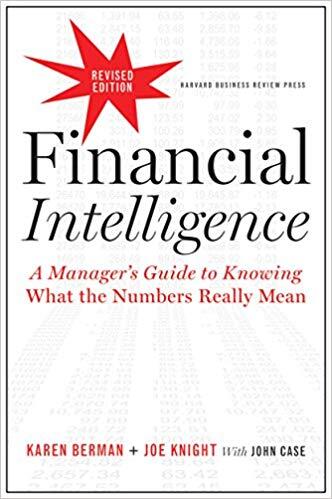Financial Intelligence
Review Financial Intelligence: A Manager’s Guide to Knowing What the Numbers Really Mean
by KAREN BERMAN, JOE KNIGHT, JOHN CASE
Description
This book delves into the analysis of financial statements. The authors discuss its various aspects in a simplified and practical manner. This book is not only about corporate finance, but also the complexities of analyzing financial statements—or the numbers—making this a perfect book for managers or business graduates looking to review the basics once again.
It offers a direct-to-the-point and simple approach to financial statement analysis, without the complexities of the subject. When technical terms are discussed, the authors make sure to explain it in the most understandable way, which also makes it more relatable to real-world scenarios.
Accounting and Finance may not be everyone’s expertise, but this book will surely welcome the reader to the fundamentals of these topics and make it a fun and interesting read along the way.
About the Authors
KAREN BERMAN and JOE KNIGHT founded the Business Literacy Institute, which is based in Los Angeles. They train managers of various organizations like the American Express, Pacific Life, Procter & Gamble, GM, and Tyco International.
Table of Contents
Preface: What Is Financial Intelligence?
PART ONE: THE ART OF FINANCE (AND WHY IT MATTERS)
- You Can’t Always Trust the Numbers
- Spotting Assumptions, Estimates, and Biases
- Why Increase Your Financial Intelligence?
- The Rules Accountants Follow—and Why You Don’t Always Have To
Part One Toolbox:
Getting What You Want; The Players and What
They Do; Reporting Obligations of Public Companies
PART TWO: THE (MANY) PECULIARITIES OF THE INCOME STATEMENT
- Profit Is an Estimate
- Cracking the Code of the Income Statement
- Revenue: The Issue Is Recognition
- Costs and Expenses: No Hard-and-Fast Rules
- The Many Forms of Profit
Part Two Toolbox:
Understanding Variance; Profit at Nonprofits;
A Quick Review: “Percent of” and “Percent Change”
PART THREE: THE BALANCE SHEET REVEALS THE MOST
- Understanding the Balance Sheet Basics
- Assets: More Estimates and Assumptions (Except for Cash)
- On the Other Side: Liabilities and Equity
- Why the Balance Sheet Balances
- The Income Statement Affects the Balance Sheet
Part Three Toolbox:
Expense? Or Capital Expenditure?;
The Impact of Mark-to-Market Accounting
PART FOUR: CASH IS KING
- Cash Is a Reality Check
- Profit ≠ Cash (and You Need Both)
- The Language of Cash Flow
- How Cash Connects with Everything Else
- Why Cash Matters
Part Four Toolbox:
Free Cash Flow; Even the Big Guys Can Run Out of Cash
PART FIVE: RATIOS: LEARNING WHAT THE NUMBERS ARE REALLY TELLING YOU
- The Power of Ratios
- Profitability Ratios: The Higher the Better (Mostly)
- Leverage Ratios: The Balancing Act
- Liquidity Ratios: Making the Most of Your Assets
- Efficiency Ratios: Can WE Pay Our Bills
- The Investor’s Perspective: The “Big Five” Numbers and Shareholder Value
Part Five Toolbox:
Which Ratios Are Most Important to Your Business?;
The Power of Percent of Sales; Ratio Relationships;
Different Companies, Different Calculations
PART SIX: HOW TO CALCULATE (AND REALLY UNDERSTAND) RETURN ON INVESTMENT
- The Building Blocks of ROI
- Figuring ROI: The Nitty-Gritty
Part Six Toolbox:
A Step-by-Step Guide to Analyzing Capital Expenditures;
Calculating the Cost of Capital; Economic Value Added
And Economic Profit—Putting It All Together
PART SEVEN: APPLIED FINANCIAL INTELLIGENCE: WORKING CAPITAL MANAGEMENT
- The Magic of Managing the Balance Sheet
- Your Balance Sheet Levers
- Homing In on Cash Conversion
Part Seven Toolbox:
Accounts Receivable Aging
PART EIGHT: CREATING A FINANCIALLY INTELLIGENT COMPANY
- Financial Literacy and Corporate Performance
- Financial Literacy Strategies
- Financial Transparency: Our Ultimate Goal
Part Eight Toolbox:
Understanding Sarbanes-Oxley
Appendix: Sample Financials
Notes
Acknowledgments
Index
About the Authors
